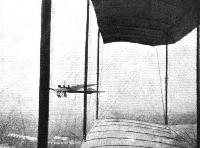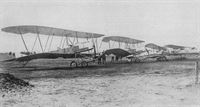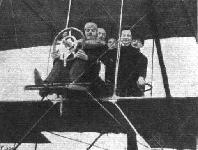J.Herris Albatros Aircraft of WWI. Vol 1: Early Two-Seaters (A Centennial Perspective on Great War Airplanes 24)
Albatros Pre-War Aircraft
<...>
The Antoinette was a primitive design, and later in 1910 Albatros built the Farman biplane under license as the F1; a longer-span variant was produced as the F2.
In 1911 Albatros built the French-designed Sommer S1 single-seat pusher biplane, followed by the RS1, a shorter-span S1, for contests. The SZ1 followed; it was similar to the RS1 but had a 70 hp Gnome rotary and a nacelle for the pilot.
<...>
Показать полностью
M.Dusing German Aviation Industry in WWI. Volume 1 (A Centennial Perspective on Great War Airplanes 84)
Albatros-Werke GmbH, Berlin-Johannisthal (Alb)
Captain (ret.) Dr. Walther Huth carefully studied the development of aviation, especially the progress in France.
Believing in the positive signals and in the conviction of a profitable business, Dr. Huth had a hangar built for 6,000 Marks at the first German airfield at Johannisthal near Berlin. The company founded here under the name “Ikaros-Gesellschaft” intended to carry out demonstration flights all over Germany with one and two-seater Antoinette monoplanes. In 1910, a Farman III biplane was added. At the first international air show in August 1909, the Grande Semaine d’Aviation de la Champagne, the Farman machine had won the long distance prize and the Antoinette the high altitude prize. These machines were used as training aircraft and as patterns for license replication in the later Albatros factories. In addition to the Antoinette and Farman types, the three best-known Albatros replicas were the French summer biplane. All aircraft were successfully flown and used in student pilot training.
In the absence of trained pilots, Dr. Huth sent his chauffeur Simon Brennhuber and the employed engineer Eugen Wiencziers to France to learn to fly.
On December 20, 1909, the "Ikaros-Gesellschaft“ was renamed „Pilot-Flugtechnische Gesellschaft". Initially, no aircraft were designed, built or sold. The French airplanes, which had arrived in the meantime, were demonstrated at various air shows, mainly by Wienczier, and won several prizes.
On December 29, 1909, Dr. Huth renamed the company “Albatros-Werke” to implement his acquired license rights to build French airplanes. As early as the spring of 1910, with the participation of other financiers, including engineer Otto Wiener, the “Albatros-Werke” was transformed into a limited liability company GmbH.
The Farman aircraft, imported from France by Albatroswerke, was sold to the Army Administration on December 18, 1910, having already been loaned out for military pilot training at Doberitz. Under the Army designation “B.I”, it was the first German military aircraft. Among the five other “flying machines” acquired by the German Army Administration at the end of 1910 were a Farman and a Sommer biplane, two French types copied from Albatros. In 1911, further important development steps followed with the first in-house design, the MZ 1 twin pigeon, and with the victory of Benno Konig on Albatros-Farman in the Deutschlandflug.
During 1912, five Albatros F.2s were built, a further development of the French Farman III biplane (hence the letter F) with a gondola for the crew and Argus in-line engine instead of the original Gnome rotary engine. Four aircraft were delivered to the newly formed Bulgarian Aircraft Department, where they participated in the Balkan Wars of 1912-1913. One of them flew its first military mission in the skies over Europe on October 16,1912.
<...>
Aircraft Development:
<...>
1911: In this year the company released an improved Sommer-Farman type, equipped with 70 hp Gnome 7-cylinder rotary engine. The flight requirements placed on the flying machine were: Minimum speed: 60 km/h. The aircraft must be able to fly for 30 minutes at an altitude of at least 300 m with foil load. The takeoff distance was not allowed to exceed 50 m.
At the same time, a military type was also created: M.Z. 2, a biplane with a 100 hp Argus engine weighing 480 kg, equipped with two protected seats and dual controls with levers. The engine was located in the rear, pressurized propeller. Speed was 80 km/h. At the end of the year, another Farman type with 50 hp Gnome and 70 hp Renault engine was developed. The required performances were now: Minimum speed 60 km/h, 2 hours flight time at minimum altitude 300 m.
1912/13: During this period the military type 1912 (VM.Z. 1) was built, which was a biplane equipped with a 100 hp Argus engine. The total weight was 420 kg, the payload 300 kg. Fuel was available for 4 hours, maximum speed was 90 km/h.
<...>
Показать полностью
Журнал Flight
Flight, December 10, 1910
Passenger Carrying by Brunnhuber.
SIMON BRUNNHUBER, who has just been appointed instructor at the Military Aviation Ground at Doeberitz by the Prussian War Minister, accomplished a notable performance on the 24th ult. Using his German-built Sommer machine, he took up three passengers beside himself, and carried them for 2 1/2 kiloms., landing after a three minutes flight in splendid style.
Flight, December 17, 1910
Doings at Johannisthal.
ORVILLE WRIGHT was at the Johannisthal flying ground on the 6th inst, and made a flight of several circuits of the aerodrome at a height of 150 metres. On the following day Brunnhuber repeated his exploit of taking four passengers with him on his Farman machine for two circuits of the ground, while Capt. Engelhardt, on a new Wright biplane, made a cross-country flight at a height of 300 metres, passing over Glienicke, Schoenefeld, Eichwalde, Gruenau, to Aldershof and back.
It is a rather curious coincidence that two of the aviators at Johannisthal should have met with trouble through losing their propellers last week-end. On Saturday afternoon Brunnhuber was flying on his German-built Farman at a height of 50 metres when the propeller dropped off, but the aviator was able to land safely and without damage. Two days later Thelen was giving a passenger a trip on his Wright biplane when the starboard propeller fell off. The machine dropped suddenly from a height ot six metres to the ground and although Thelen himself was unhurt, the passenger was rather severely shaken up, while the machine was smashed.
Last week a deputation of Russian military officers paid a visit to the Johannisthal Flying Ground, where they were especially interested in the Albatross Works, which builds Farman biplanes in Germany. It is rumoured that the Russian Government intend to order a number of aeroplanes from this firm.
Flight, November 18, 1911.
FOREIGN AVIATION NEWS.
Flying Round Berlin.
ON Monday Pietschker, accompanied by Lieut. Schwarz on an Albatross biplane, started from Johannisthal and making his way round the north of Berlin, flew to Potsdam. Proceeding on his way to the south of the German capital, he landed at Schulzendorf in order to visit a friend, and then steered his way back to Johannisthal via Telton and Templehof, having taken 1 hr. 40 mins. for the round trip.
Показать полностью









